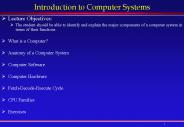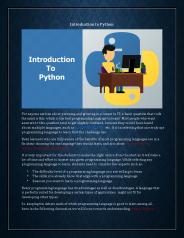VHDL1 Introduction to VHDL VeryHighSpeedIntegratedCircuits Hardware Description Language KH Wong
1 / 26
Title:
VHDL1 Introduction to VHDL VeryHighSpeedIntegratedCircuits Hardware Description Language KH Wong
Description:
How many IO pins? What are their names and types? ... equals, a,b are I/O signal pins designed by the user in the entity declaration. ... –
Number of Views:161
Avg rating:3.0/5.0
Title: VHDL1 Introduction to VHDL VeryHighSpeedIntegratedCircuits Hardware Description Language KH Wong
1
VHDL1Introduction to VHDL(Very-High-Speed-Integr
ated-Circuits Hardware Description Language) KH
Wong
- (Some pictures are obtained from FPGA
ExpressVHDL Reference Manual, it is accessible
from the machines in the lab at /programs/Xilinx
foundation series/VDHL reference manual)
2
You will learn
- Basic structure
- Entity
- declaration
- architecture
3
Resource references
- Book
- Fundamentals of digital logic with VHDL design,
Brown and Vranesic, Macgraw Hill 2000. - Foundation series software, XILINX student
edition (contains a CDROM with design tools for
Xilinx), Prentice Hall. - Online resource , software in the lab.
4
Web resource on VHDL (plenty)
- Courses and tools
- http//equipe.nce.ufrj.br/gabriel/vhdlfpga.html
- VHDL Quick Reference http//www.doulos.co.uk/hegv/
5
What is an entity?Overall structure of a VHDL
file
6
What are they?
A VHDL file
Defines Input/Output pins
Library declaration, e.g. IEEE library
Entity declaration
Entity
Architecture body
The processing
7
An example a comparator in VHDL
Aa3,a2,a1,a0 Bb3,b2,b1,b0
equals
VHDL for programmable logic, Skahill, Addison
Wesley
a3 a2 a1 a0
The comparator chip eqcomp4
b3 b2 b1 b0
equals
8
Exclusive or (XOR)
- Exclusive or (XOR)
- When AB, Out is 1
- Otherwise it is 0
9
An example of a comparator
Entity declaration define IOs
- 1 entity eqcomp4 is
- 2 port (a, b in std_logic_vector(3 downto 0 )
- 3 equals out std_logic)
- 4 end eqcomp4
- 5
- 6 architecture dataflow1 of eqcomp4 is
- 7 begin
- 8 equals lt '1' when (a b) else '0
- 9-- comment equals is active high
- 10 end dataflow1
Entity declaration
Architecture body
10
How to read it?
Entity enclosed by the entity name eqcomp4
(entered by the user)
- A bus, use downto to define it.
- E.g. in std_logic_vector(3 downto 0)
- 1 entity eqcomp4 is
- 2 port (a, b in std_logic_vector(3 downto 0 )
- 3 equals out std_logic)
- 4 end eqcomp4
- 5
- 6 architecture dataflow1 of eqcomp4 is
- 7 begin
- 8 equals lt '1' when (a b) else '0
- 9-- comment equals is active high
- 10 end dataflow1
Port defines the I/O pins.
Entity declaration
Architecture body
11
Entity declarationdefine the IO pins of the chip
- entity eqcomp4 is
- port (a, b in std_logic_vector(3 downto 0 )
- equals out std_logic)
- end eqcomp4
Two input buses (a3,a2,a1,a0) (b3,b2,b1,b0) and
one output equals
a3 a2 a1 a0
The comparator chip eqcomp4
b3 b2 b1 b0
equals
12
Concept of signals
- A signal is used to carry logic information.
- In hardware it is a wire.
- A signal can be in or out ..etc.
- There are many logic types of signals (wires)
- Bit (can only have logic 1 or 0)
- Std_logic can be 1, 0 , Z ..etc. ( Zfloat.)
- Std_logic_vector is a group of wires (called
bus). - a, b in std_logic_vector(3 downto 0) in VHDL
- means a(0), a(1), a(2), a(3) are std_logic
signals - Same for b.
(meaning Standard logic, an IEEE standard)
13
Exercise 1.0
- In the eqcomp4 VHDL code
- How many IO pins?
- What are their names and types?
- What are the meanings of std_logic and
std_logic_vector?
14
Entity declaration
- Define Input/Output (IO) pins
15
Exercise 1.1a
- 1 entity test1 is
- 2 port (in1,in2 in bit
- 3 out1 out bit
- 4 end test1
- 5
- 6 architecture test1arch of test1 is
- 7 begin
- 8 out1lt in1 or in2
- 9 end test1_arch
- Give line numbers of (i) entity declaration, and
(ii) architecture? Also find an error in the
code. - What are the functions of (i) entity declaration
and (ii) architecture? - Draw the chip and names the pins. (Dont forget
the two most important pins) - Underline the words that are user defined in the
above VHDL code.
16
Exercise 1.1b
- Rewrite example 1.1a, with
- Entity name is not test1 but test1b
- Inputs are not in1 and in2 but a,b, resp.
- Output is not out1 but out1b
- Logic type is not bit but std_logic
- Architecture name is not test1arch but
test1b_arch.
17
More on Entity Declaration
- entity do_care is port(
- s in std_logic_vector(1 downto 0)
- y buffer std_logic)
- end do_care
- 4 modes of IO pins in port
- in,
- out,
- inout (bidirectional)
- buffer (can be read back by the entity)
User defined variables are in Italic.
18
4 modes of IO signals
- Declared in port declaration
19
IN, OUT, INOUT, BUFFER modes
- IN data flows in, like an input pin
- OUT data flows out, just like an output. The
output cannot be read back by the entity - INOUT bi-directional, used for data lines of a
CPU etc. - BUFFER similar to OUT but it can be read back by
the entity. Used for control/address pins of a
CPU etc.
20
Exercise 1.2 Example/Exercise IN, OUT, INOUT,
BUFFER
- Draw the schematics of the four types
- Based on the following schematic, identify the
modes of the IO pins.
From VHDL for programmable logic, Skahill,
Addison Wesley
21
The architecture body
- Define the internal architecture/operation
22
Architecture body defines the operation of the
chip
- Begin
- tells you the internal operation..
- ..
- end
- 6 architecture dataflow1 of eqcomp4 is
- 7 begin
- 8 equals lt '1' when (a b) else '0
- 9 -- comment equals is active high
- 10 end dataflow1
Architecuture body
Architecture body
23
How to read it?
- Architecture name -- dataflow1(entered by the
user) - equals, a,b are I/O signal pins designed by the
user in the entity declaration. - The operation equals lt '1' when (a b) else
'0 - -- means comment
6 architecture dataflow1 of eqcomp4 is 7
begin 8 equals lt '1' when (a b) else '0 9--
comment equals is active high 10 end dataflow1
24
Exercise 1.3 Draw the schematic circuit
- 1 entity test is
- 2 port (in1 in std_logic_vector (2 downto 0)
- 3 out1 out std_logic_vector (3 downto
0)) - 4 end test
- 5 architecture test_arch of test is
- 6 begin
- 7 out1(0)ltin1(1)
- 8 out1(1)ltin1(2)
- 9 out1(2)ltin1(0) and in1(1)
- 10 out1(3)lt1
- 11 end test_arch
25
Exercise 1.4 Write the entity of this device
- Fill in the truth table and write the VHDL code
26
Quick revision
- You should know
- Entity
- Entity declaration
- Use of port()
- Modes of IO signals
- Structure of a simple Architecture body































